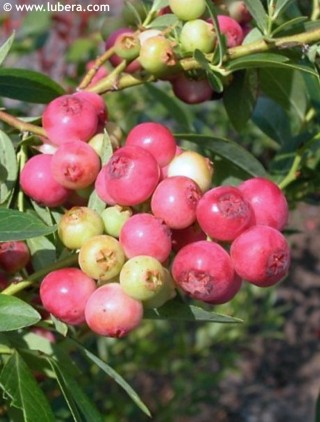
Vaccinium Pinkberry® + ODRŮDY pink blueberry


The fruit is very sweet, juicy, and lack the typical wild blueberry acidity. The bush is more upright and somewhat leggy, its twigs grow faster and do not form a very ornamental habit. Leaves are rather pointed, narrowly elliptic, mid green, turning orange and scarlet red in autumn. Pinkberry® is described as self-fertile, however, high yield and much better fruit quality was gained only with another Pinkberry® or rabbitberry variety nearby.
VARIETIES
Pink Lemonade® (syn. Pink Sapphire™) – mid season, historically the very first bred and described variety of blueberries with pink fruit, made by Mark Ehlenfeldt from USA. Fruit is rich fuchsia pink, mid-sized, very sweet, and mature in August.
Moreberry® – mid season, it is not truly a variety but a good trick by a Swiss breeding company Lubera®, these are two varieties planted in one pot, which benefit from each other as they are perfect pollination partners - Pink Lemonade® with pink fruit from early August, and Blue Buddy® with blue fruit from late August.
Pink Berry – this unpatented variety is a European, possibly German mutation of Pink Lemonade®, using a common name Pinkberry® as a variety rather than a type, fruit is identical to Pink Lemonade®.
CULTIVATION
Pinkberry® is as fussy about growing conditions as any highbush blueberry. It needs a location in full sun (unlike forest blueberries), and constantly moist, acid soil (ph 3,5-4) rich in organic matter. Some growers even suggest wet soil but we have not tested this. It benefits from annual fertilizing in early spring. Pruning is not necessary but can be done to rejuvenate older plants. Do this after harvest. Fruiting begins later than on highbush blueberries, usually on 4-5 year-old plants. Hardiness is still a subject of testing. Plants were originally released for USDA zone 7, but now (in 2016) are rated hardy to about -24°C (USDA zone 6), and some sources say they might also withstand USDA zone 4 (-34°C) which seems unlikely knowing that one of the parents (rabbiteye blueberry) is hardy to zone 7 only but further tests will show.
Last update 11-01-2017
Goods are shipped all over Europe. For Russia and U.K. and for further details please read about SHIPPING OPTIONS HERE.
Are you interested in a serious discount for orders NOV-FEB? Check your options here.
THE PRICES INCLUDE VAT of 15%. For quick conversion you can use 1 CZK = approx. 0.04 EUR
- STANDARD QUALITY - Plants of this group are 1st class quality with number of branches and overall density adequate to their size and age, considering they were container grown.
- DE LUXE QUALITY - This label guarantees a luxurious quality of manually selected plants that, compared to their height and age, are exceptionally dense and beautiful.
- EXTRA - These plants are usually mature and bigger specimens with exceptional overall appearance.
- STANDARD (as described in the plant form) means a tree with a trunk of 190-210 cm and a crown at the top, unless specified differently. The commercial size for trees is their girth measured in the height of 1m from ground.
- HOBBY - These plants are of the same quality as our standard-quality plants but younger and therefore cheaper.
- SHRUB - a woody plant with branches growing bushy from the ground level.
- HALF-STANDARD or MINI-STANDARD - a small tree with shorter trunk, its size is usually specified.
- FEATHERED - These are trees with branches growing already from the base of the trunk and up along the stem.
- GRASSES and PERENNIALS - Sizes given usually read the diameter of the pot or the clump, as specified.












